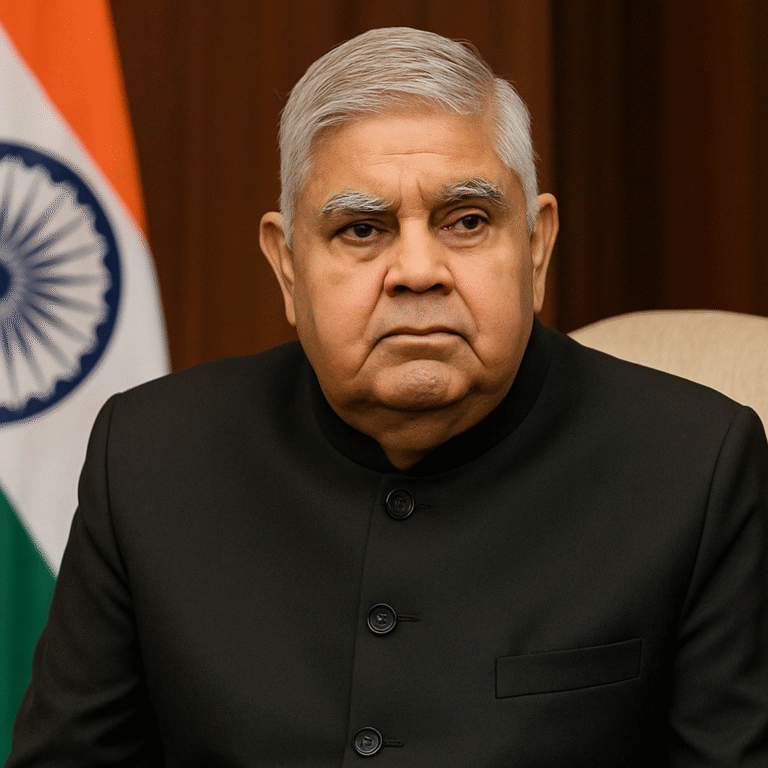
On the very first day of the Monsoon Session of Parliament (Monday), Vice President Jagdeep Dhankhar shocked the nation by resigning from his post, citing health reasons. His resignation was submitted to President Droupadi Murmu, and it took effect immediately under Article 67(a) of the Constitution.
Although Dhankhar, 74, had remained active throughout the day—presiding over the Rajya Sabha, swearing in new members, and even handling sensitive matters like an impeachment notice against High Court judge Yashwant Varma—he abruptly stepped down in the evening. This timing has raised questions and suspicions, with many political leaders and commentators saying the resignation was unexpected and possibly linked to reasons beyond health.
Prime Minister Narendra Modi responded on X (formerly Twitter), appreciating Dhankhar’s long service and wishing him good health.
Opposition leaders, including Anand Dubey (Shiv Sena UBT), Manish Tewari, and Jairam Ramesh (Congress), expressed surprise and skepticism, suggesting that there may be “more than meets the eye”. Ramesh also highlighted Dhankhar’s reported displeasure over being uninformed about absent ministers during an important advisory committee meeting earlier in the day.
Dhankhar, a seasoned lawyer and politician, previously served as Governor of West Bengal and MP from Rajasthan’s Jhunjhunu. He joined the BJP in 2003 and became Vice President in August 2022, with a term originally set to run till 2027. He also underwent angioplasty in March, but had since resumed full duties.
With the vice-presidential post now vacant, his duties will be temporarily handled by the Deputy Chairperson of the Rajya Sabha or an alternative member designated by the President.
Key Points:
Jagdeep Dhankhar resigned citing health reasons on Monsoon Session’s first day.
Active participation in Parliament earlier in the day sparked surprise at the sudden decision.
Opposition questions timing; sees political undercurrents.
PM Modi acknowledged his contributions and wished him well.
Dhankhar’s term was to run till August 2027.
Responsibilities to be reassigned until a new VP is appointed.
More Information:
The Vice President of India is elected through an indirect election process, governed by Article 66 of the Indian Constitution. Here’s a simple breakdown of how the Vice President is elected:
🗳️ Election Process of the Vice President of India
1. Electoral College
The Vice President is elected by an Electoral College, consisting only of members of both Houses of Parliament:
Lok Sabha (Lower House)
Rajya Sabha (Upper House)
Nominated members of both Houses are also eligible to vote.
State Legislative Assemblies are not involved in this election (unlike the Presidential election).
2. Voting System
The election is held through a secret ballot using the proportional representation system by means of the single transferable vote (STV).
Each MP marks their preference on the ballot paper (1st, 2nd, 3rd choice, etc.).
3. Nomination Requirements
A candidate must be:
A citizen of India
At least 35 years old
Eligible to be elected as a Rajya Sabha member
The nomination must be supported by at least 20 proposers and 20 seconders (all must be MPs).
4. Role of the Election Commission
The Election Commission of India conducts the election.
It announces the election schedule, supervises the process, and counts the votes.
5. Term and Oath
The Vice President is elected for a term of 5 years.
They take oath before the President of India.
Can be re-elected any number of times.
🏛️ Role of the Vice President
Ex-officio Chairman of the Rajya Sabha (Upper House)
Acts as President of India in their absence (until a new President is elected, if the position is vacant).